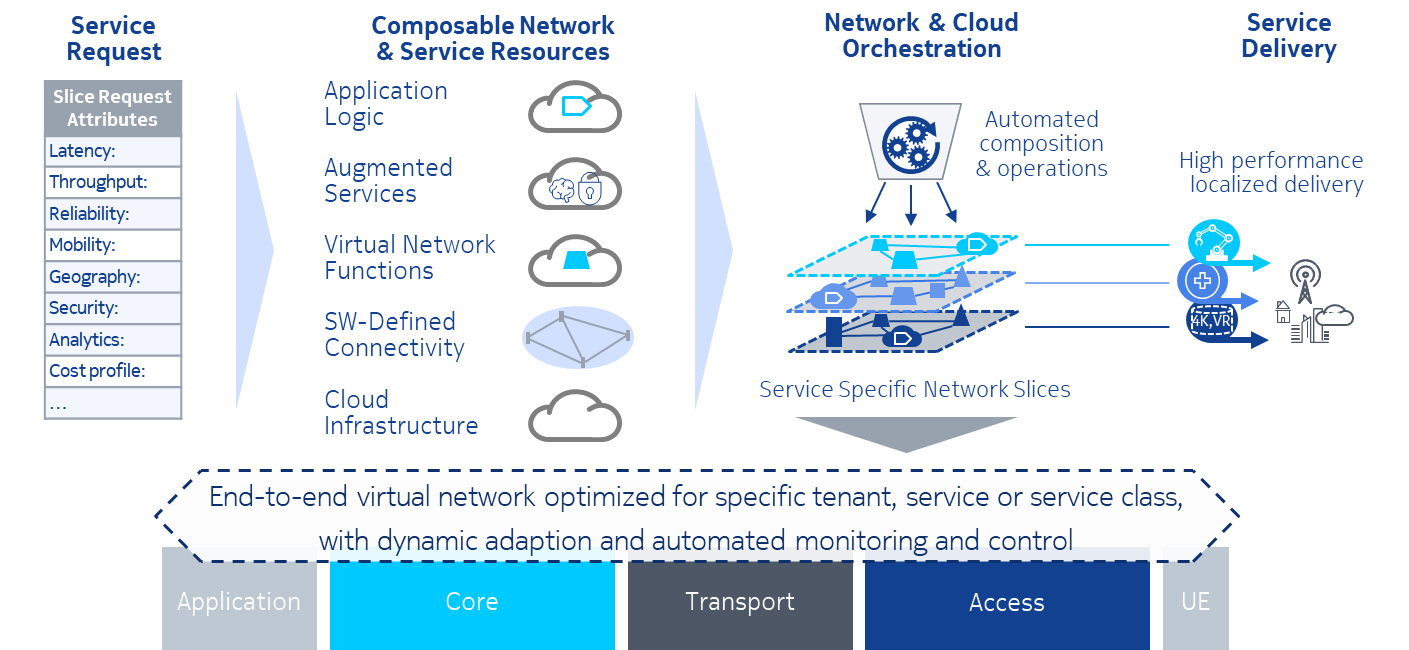Major stride in enabling a broad variety of new premium services at scale and innovative business models
The ETSI ZSM end-to-end network slicing specification has been released.
Network slicing is expected to become a fundamental enabler for value generation: a $300 billion global revenue opportunity by 2025, according to the GSMA.
It has been designed to support a broad variety of use cases (including the unknown) with extreme requirements, providing tailored network capabilities for each individual service. But building a network that supports tens of thousands of individual slices – all of which can be created and set up, operated, scaled, assured to meet each slice’s service-level agreement (SLA), and torn down at a moment’s notice – presents several challenges.
As depicted in Figure 1, each and every slice spans multiple technological domains and is composed of cloud resources, connectivity, virtual and physical network functions, augmenting services and application logic. The network includes hundreds of thousands of network functions, and each function has multiple versions.

Figure 1: End-to-end network slicing
How can we manage this complexity, deliver services with agility and speed, adapt, assure and ensure the economic sustainability of the highly diverse services offered? Unprecedented operational agility is required to support network slicing, allow slices to be dynamically created and optimized for specific market segments with minimal effort, and seamlessly assured – similar to the way in which cloud providers offer on-demand, managed cloud services.
Automation is the key to operating and managing network slicing in a profitable way. The ultimate automation target is a largely autonomous operation driven by high-level policies and rules, enabling self-configuration, self-monitoring, self-healing and self-optimization without further human intervention.
This requires a new, open and flexible approach which will enable the full automation of life-cycle management of network slices, as well as near-real-time, closed-loop automation based on data-driven analytics. Advanced machine-learning algorithms and artificial intelligence will be essential tools to deal with the complexity and diversity of network slices for a broad set of vertical segments.
ETSI ZSM has recently released the specification (GS ZSM 003) of an architecture blueprint (based on the ZSM architecture specified in GS ZSM 002) and solutions for zero-touch management and orchestration of end-to-end, cross-domain network slicing – supporting both fulfilment and assurance processes. The fulfilment processes support the lifecycle management of end-to-end network slice instances, including their instantiation, activation, operation, de-activation and decommissioning. The assurance services ensure that an end-to-end network slice instance is free of issues and meets its service-level requirements.
Network slicing spans different technological domains, from the User Equipment (UE) through, for example, the access network, transport network, core network, to the application. Various SDOs (e.g. 3GPP SA5, IETF), open-source initiatives (e.g. ONAP) and industry associations
(e.g. GSMA) tackle different parts of the solution that lie within their respective competencies. GS ZSM 003 leverages the work specified by these organizations, stitches them together and provides a federated solution.
The ZSM end-to-end network slicing specification supports multiple scenarios and a variety of new business models, all made possible by the introduction of network slicing and third-party tenants (e.g., verticals) as key business stakeholders. These scenarios move from “lean” models where the tenant of a network slice instance is “slice unaware” – consuming and optionally monitoring communication services – to “Network Slice as a Service” (NSaaS) models where the tenant is “slice aware” – and can use the network slice instance and optionally have extended control to manage it via management exposure interfaces. NSaaS provides the consumer
(e.g. vertical) with a simple, on-demand and elastic access to a network slice instance while hiding all the complexity of the federated solution. The level of control provided to the consumer depends on the business model.
The alignment and leverage of synergies across ETSI ZSM, 3GPP, O-RAN, IETF, BBF, TMF, GSMA NEST, etc. is essential to enable the delivery of end-to-end network slicing that can satisfy the requirements from vertical industries and the demands of network operators. In accordance with its mission, ZSM plays a central role in facilitating coordination and providing guidance. The ETSI ISG ZSM will continue to strengthen collaboration across the industry in order to promote the adoption of and alignment with the ZSM architecture and solutions, ensuring that automated end-to-end network and service management can be achieved.

